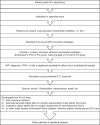Polyurethane cuffed versus conventional endotracheal tubes: Effect on ventilator-associated pneumonia rates and length of Intensive Care Unit stay
- PMID: 27053778
- PMCID: PMC4800931
- DOI: 10.4103/0019-5049.177871
Polyurethane cuffed versus conventional endotracheal tubes: Effect on ventilator-associated pneumonia rates and length of Intensive Care Unit stay
Abstract
Background and aims: Ventilator-associated pneumonia (VAP) is a major cause of morbidity and mortality among patients in the Intensive Care Units (ICUs) and results in added healthcare costs. One of the methods of preventing VAP is to use polyurethane (PU)-cuffed endotracheal tube (ETT). This study compares the incidence of VAP and length of ICU stay in patients intubated with conventional polyvinyl chloride (PVC) ETT and PU-cuffed ETT.
Methods: Eighty post-laparotomy patients who were mechanically ventilated for >48 h in the ICU were included in this randomised controlled trial. Patients with moderate to severe pre-existing lung conditions were excluded from the study. Patients in group PVC (n = 40) were intubated with conventional PVC-cuffed ETT and those in group PU (n = 40) with PU-cuffed ETT. VAP was defined as a Clinical Pulmonary Infection Score of >6 with a positive quantitative endotracheal culture in patients on ventilator for >48 h.
Results: Overall VAP rates were 23.75%. Thirteen (32.5%) patients in group PVC and six (15%) patients in group PU developed VAP. ICU stay was significantly lesser in patients intubated with PU-cuffed ETT (group PU) (median, 6 days; range: 4-8.5) compared to patients intubated with conventional ETT (group PVC) (median, 8; range: 6-11).
Conclusion: No statistically significant reduction in the incidence of VAP could be found between the groups. The length of ICU stay was significantly lesser with the use of ultra thin PU-cuffed ETTs.
Keywords: Polyurethane cuff; polyvinyl chloride cuff; ventilator-associated pneumonia.
Figures
References
-
- American Thoracic Society; Infectious Diseases Society of America. Guidelines for the management of adults with hospital-acquired, ventilator-associated, and healthcare-associated pneumonia. Am J Respir Crit Care Med. 2005;171:388–416. - PubMed
-
- Dodek P, Keenan S, Cook D, Heyland D, Jacka M, Hand L, et al. Evidence-based clinical practice guideline for the prevention of ventilator-associated pneumonia. Ann Intern Med. 2004;141:305–13. - PubMed
-
- Lorente L, Lecuona M, Jiménez A, Mora ML, Sierra A. Influence of an endotracheal tube with polyurethane cuff and subglottic secretion drainage on pneumonia. Am J Respir Crit Care Med. 2007;176:1079–83. - PubMed
-
- Pugin J, Auckenthaler R, Mili N, Janssens JP, Lew PD, Suter PM. Diagnosis of ventilator-associated pneumonia by bacteriologic analysis of bronchoscopic and nonbronchoscopic “blind” bronchoalveolar lavage fluid. Am Rev Respir Dis. 1991;143(5 Pt 1):1121–9. - PubMed
-
- Poelaert J, Depuydt P, De Wolf A, Van de Velde S, Herck I, Blot S. Polyurethane cuffed endotracheal tubes to prevent early postoperative pneumonia after cardiac surgery: A pilot study. J Thorac Cardiovasc Surg. 2008;135:771–6. - PubMed
LinkOut - more resources
Full Text Sources
Other Literature Sources


